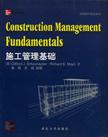施工管理基础
出版时间:2005-5 出版社:重庆大学出版社 作者:(美)克里夫德 页数:298
前言
The construction industry has changed dramatically in the last 25 years and.driven by the capabilities of the computer chip,change is continuing at all evenmore rapid pace.We are in the age of the laptop computer and the Internet.Withour computer systems we now move data directly from the designerS comput-ers to the field.This abundance ofdata must,however,be turned into informa-tion that will help US better manage construction operations.The challenge is todo things not only faster but better.Technology improvements will greatlyenhance the constructor’S ability tO make better decisions relating to equipment,planning,and construction methods. This text iS intended for use in Constructing Management courses forundergraduate Civil Engineering students or for the Construction Managementgraduate students who need a text that covers the fundamentals of constructionin a logical,simple,and concise format.Cons,truction management is about con-trolling time,cost,quality,and safety,and about acting in a socially,politically,and environmentally acceptable manner.These tenets are covered in Construc.tion Management Fundamentals.With a solid understanding of these concepts,the designer and constructor are better prepared to make intelligent design deci.sions,and to interact in a meaningful and productive manner. Many photographs from actual projects are included in the text to illustrateideas and construction methods.Additionally.the use of examples to reinfcIrcethe concepts through application has been incorporated in the text.Based on pro-fessional practice,standard formats for analyzing common problems are pre-sented.Many companies use such formats to avoid errors when estimating pro.duction during the fast-paced efforts required for bid preparation and closing. To enhance the value of Construction Management Fundamentals as a c01.1ege textbook,problems and questions are provided at the close of each chapter.The solutions to some problems are included in the text at the end of the problemstatements.Together with examples.they facilitate learning and give students theconfidence that they can master the subjects presented.There are some questionsthat require the student to search construction publications or Web.based sourcesto locate basic information in support of construction management decisions.These questions expose the student to the process of independently locating nec-essary information.At the close of each chapter there are names,addresses,andin many cases tlle Interact address.for sources of additional information.
内容概要
本书是根据CliffordJ.Schexnayder所著的《Construction Management Fundamentals》一书缩编而成。原书共有17章,从承包商的角度,分别就施工项目管理的发展历史、基本功能、招投标工作、计较技术、工料测算、项目合同、施工会计、设备选择、费用估算、建筑材料、施工安全、质量控制以及施工管理发展趋势等几方面的内容进行了介绍。 在缩编中,主要把原书中关于美国施工管理发展的内容,以及不太适合我国现行施工管理体系的施工会计、合同法律、机械设备使用等部分作了删减,保留了承包商进行项目管理以及项目管理的常用方法等内容,希望本书能够为读者提供一个比较完整的项目管理框架。
书籍目录
PART 1Construction ManagementCHAPTER 1 Construction Management Project Planning and Design Master Planning Planning Phase Designer Selection Design Phase Bid Phase Award Phase Construction Phase Partnering Project Cost and Schedule Control Construction-Related Design Value Engineering Summary Key Terms Review Questions References Website ResourcesCHAPTER 2 Scheduling Techniques for Construction Projects Introduction Activities Bar Charts Critical Path Method Precedence Logic Diagrams Calendar Date Schedule Scheduling Activities Velocity Diagram Linear Scheduling Computer Support Summary Key Terms Review Questions References Website ResourcesCHAPTER 3 Construction Cost EstimatesCHAPTER 4 Estimating Heavy/Civil ProjectsCHAPTER 5 Construction ContractsPART 2 Construction PracticeCHAPTER 6 Building MaterialsCHAPTER 7 Building Construction MethodsCHAPTER 8 Quality and ProductivityCHAPTER 9 SafetyCHAPTER 10 TrendsAppendix AGlossaryAppendix BSelected Unit Equivalents
章节摘录
VELOCITY DIAGRAMVelocity diagrams present a graphical picture of the relationship between timeand the accomplishment of an activity f Fig.2.23 1.The vertical axis of thediagram represents accomplishment of a work task:cubic yardS excavated,miles of road built.kilometers of pipeline constructed.The horizontal axispresents construction time.The slope Of the production 1ine gives the activityproduction rate.When the vertical axis represents activity completion in termsof advancement along a linear dimension.such as stations for a highway projector floors of a building iob,the velocity diagram delineates an activitys rate ofprogress in time and space.The tool focuses management attention on the rateof accomplished work. In the section on activity duration.the process of converting bid estimateproduction rates into an activity duration was demonstrated.If the bid estimateproduction rates are based on the same time unit as that of the proposed velocitydiagram,the manager can plot the diagram directly.
图书封面
评论、评分、阅读与下载
用户评论 (总计1条)
- 质量还不错,出国前准备参考书。通读完,专业词汇和表达就应该过关了
